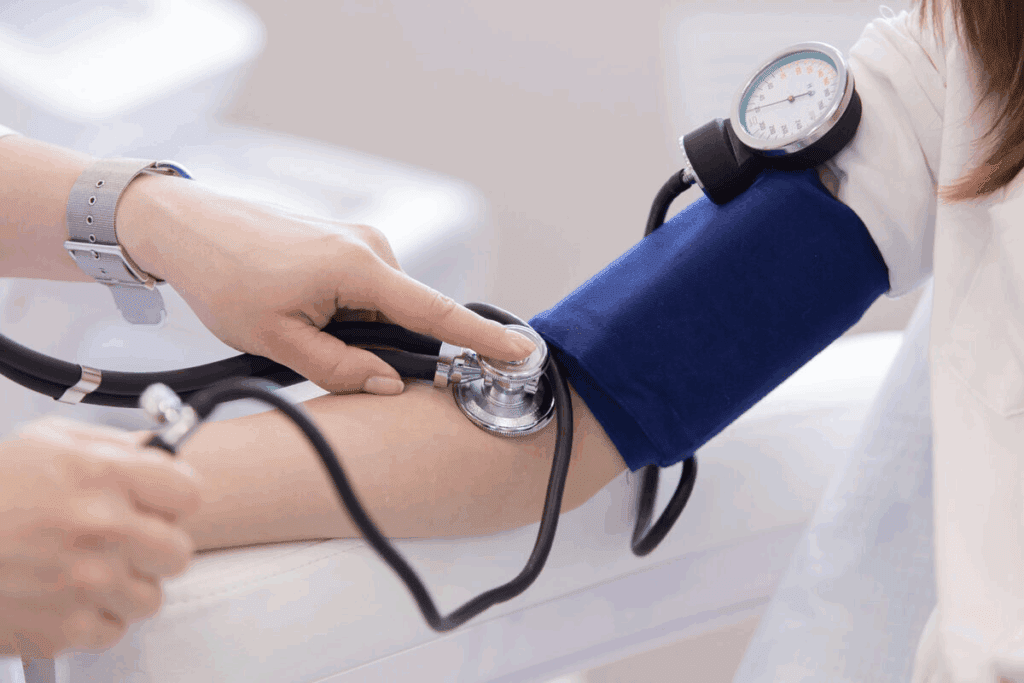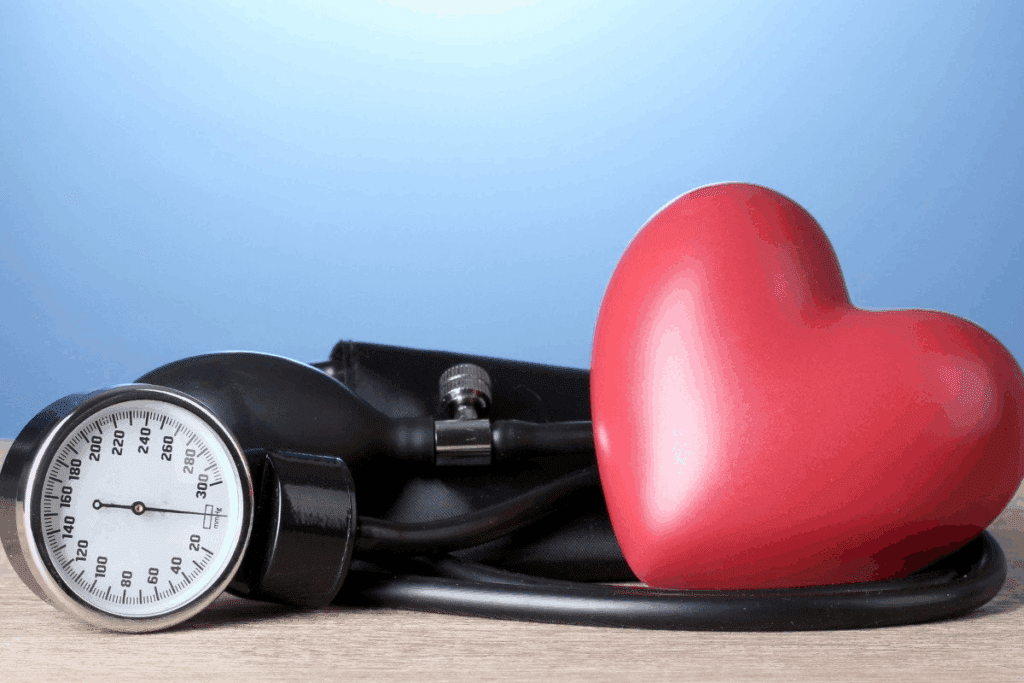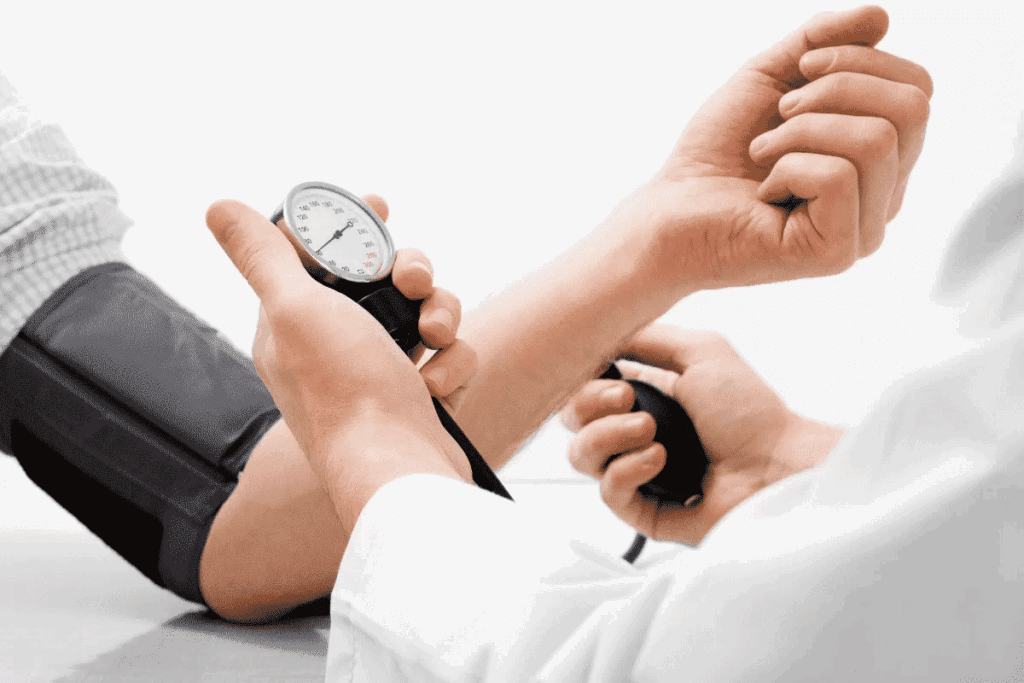
High blood pressure, or hypertension, is called a “silent killer” because it usually doesn’t show symptoms. Even when readings are very high, you might not feel anything. The American Heart Association says it’s often without symptoms, so checking your blood pressure regularly is key.
Learn about signs of high blood pressure and how to detect it early.
Some people might feel dizziness, headaches, or shortness of breath. But many don’t know they have it until it’s serious. At Liv Hospital, we stress the need to know and offer top-notch tests to spot risks.
Knowing the risks and spotting early signs can save your life. We show you how to recognize these signs and what to do to keep your health safe.

Blood pressure is the force blood pushes against artery walls. When it’s too high, it can cause serious health problems. High blood pressure, or hypertension, is when this force stays too high. It can damage blood vessels and organs.
To understand high blood pressure, we need to know what blood pressure readings mean. It’s recorded as two numbers: systolic (top number) and diastolic (bottom number). The American Heart Association says these numbers are key for diagnosing hypertension.
Blood pressure categories are based on these readings:
Knowing these categories is key to figuring out if you have high blood pressure. It helps you know what steps to take to manage it.
High blood pressure is often called a “silent killer.” It usually doesn’t show symptoms until it has already harmed organs and blood vessels. This makes regular blood pressure checks very important for early detection and management.
“The silent nature of high blood pressure means that many people are unaware they have it, highlighting the importance of regular check-ups.”
The dangers of high blood pressure are serious. If not controlled, it can lead to heart disease, stroke, kidney disease, and other heart problems. Knowing the risks and taking steps to manage blood pressure can greatly reduce these dangers.

High blood pressure is often called a “silent killer” because it usually doesn’t show symptoms. Most people with hypertension don’t feel sick. This is why it’s key to get blood pressure checks often.
Hypertension often doesn’t make you feel bad. The American Heart Association says most people with it don’t show symptoms. This makes it hard to know you have it, which is why regular health checks are important.
Even though high blood pressure is usually without symptoms, some people might feel them. Symptoms like headaches, dizziness, and nosebleeds can happen. If you notice these, you should see a doctor right away.
Knowing when symptoms show up helps you manage your blood pressure better. Keeping an eye on your blood pressure and knowing the signs of high blood pressure is key to staying healthy.
High blood pressure can show itself in many ways, with headaches being a common sign. High blood pressure often doesn’t show symptoms. But sometimes, it can cause headaches, making them a key symptom to notice.
Hypertension-related headaches can vary in how severe and what they feel like. Severe headaches might mean you have a hypertensive crisis, which is very serious and needs quick medical help. These headaches are usually very bad and feel like they’re pounding.
Not all headaches are because of high blood pressure. But when they are, they can show how bad the condition is.
Telling apart hypertensive headaches from other kinds can be hard. Hypertensive headaches are usually very bad and might come with other signs like dizziness or seeing things that aren’t there. Unlike tension headaches or migraines, hypertensive headaches are linked to high blood pressure.
To tell them apart, think about the situation and other symptoms. If you’re getting a lot of headaches or they’re really bad and you’re worried about your blood pressure, see a doctor. They can check you out and figure out what’s going on.
Knowing how headaches and high blood pressure are connected can help spot warning signs. It also helps in managing high blood pressure better.
Dizziness or lightheadedness might mean your body is trying to tell you something. It could be related to high blood pressure. These symptoms can make daily life hard, so it’s important to know how they link to high blood pressure.
Dizziness linked to high blood pressure affects the body’s blood vessels and circulation. High blood pressure can make blood vessels narrower and less flexible. This can reduce blood flow to the brain, causing dizziness or lightheadedness.
The inner ear’s vestibular system helps with balance. High blood pressure can harm this system, leading to dizziness. Also, some blood pressure medicines can cause dizziness as a side effect.
Dizziness might not always be a cause for worry, but it can be serious with high blood pressure. If you have sudden, severe dizziness, or it comes with chest pain, shortness of breath, or a bad headache, get help right away.
Keep an eye on your blood pressure and tell your doctor if you have ongoing dizziness. They can check if your dizziness is from your blood pressure or something else.
| Symptom | Possible Indication | Action Required |
| Mild, occasional dizziness | Possible side effect of medication or mild hypertension | Monitor blood pressure, consult healthcare provider |
| Sudden, severe dizziness | Potential hypertensive crisis or other serious condition | Seek immediate medical attention |
| Dizziness with chest pain or shortness of breath | Serious cardiovascular event | Emergency medical care required |
It’s key to understand how dizziness and high blood pressure are connected. By knowing the signs and when to get help, you can take care of your health better.
Unmanaged high blood pressure can cause visual disturbances. High blood pressure, or hypertension, can harm your eyes and vision. This can lead to serious problems if not treated.
Hypertension can lead to different vision issues. This is because it affects the blood vessels in the eyes. Some common problems include:
These problems happen because high blood pressure damages the retina’s blood vessels. The retina is the light-sensitive tissue at the back of the eye. This condition is called hypertensive retinopathy.
As one study noted, “Hypertensive retinopathy is a condition that can lead to vision loss if not properly managed.”
Uncontrolled high blood pressure can cause severe vision damage. The risks include:
Regular eye exams are key for those with hypertension. They help monitor eye health and catch issues early. By managing blood pressure, you can lower the risk of serious eye conditions.
“Controlling high blood pressure is key to preventing vision problems associated with hypertension.”
We suggest working closely with your healthcare provider. This helps manage your blood pressure and protect your vision.
High blood pressure and shortness of breath are linked in a complex way. High blood pressure can strain the heart and lungs. Knowing this helps us understand why we might have trouble breathing.
Hypertension can make the heart work harder, leading to heart failure. When the heart can’t pump enough, fluid builds up in the lungs. This can make it hard to breathe, even when we’re not active.
The heart and lungs work together closely. High blood pressure can hurt the heart’s ability to pump blood. This can make it hard for the lungs to get oxygen into the blood.
Shortness of breath can come from heart or lung problems. It’s important to figure out the cause to treat it right. Heart problems include heart failure and blocked arteries. Lung issues can be COPD or pneumonia.
Key differences between cardiac and pulmonary causes:
To find out why we’re short of breath, doctors use tests like echocardiograms and chest X-rays. Knowing if it’s heart, lung, or both helps them plan the best treatment.
Nosebleeds and high blood pressure are more connected than you might think. They are part of the body’s complex ways of responding to stress. Nosebleeds can happen for many reasons, like dry air, allergies, or injuries. But, if they happen a lot or are very bad, they might show a problem with blood pressure.
Studies have found a link between nosebleeds and high blood pressure. This is true when blood pressure is very high. The exact reason is not clear, but high blood pressure might make the tiny blood vessels in the nose weak and more likely to bleed.
Key factors that contribute to the link between nosebleeds and hypertension include:
Not all nosebleeds are because of high blood pressure. But, some signs should make you check your blood pressure. These signs include:
If you have nosebleeds that keep coming back or are very bad, see a doctor. They can check if high blood pressure is a problem. Catching and treating high blood pressure early can prevent bigger health problems.
Chest pain and heart palpitations are serious signs that should not be ignored. They can mean your high blood pressure is harming your heart. This could lead to serious problems if not treated quickly.
High blood pressure puts a lot of strain on the heart. It makes the heart work harder, which can cause the heart muscle to thicken. This can lead to chest pain and heart palpitations.
High blood pressure affects the heart in many ways. It changes the heart’s structure and how it functions. The high pressure can also narrow and harden artery walls, reducing blood flow to the heart.
Chest pain from high blood pressure means the heart is not getting enough oxygen-rich blood. This is a sign that needs immediate medical attention to avoid serious damage, like a heart attack.
Certain symptoms with chest pain or heart palpitations need quick medical help. These include:
If you or someone else has these symptoms, get emergency medical care right away. The American Heart Association says chest pain and shortness of breath are urgent signs if blood pressure is very high.
“The sooner you respond to the warning signs of a heart attack or other cardiac emergencies, the better your chances of survival and minimizing damage.”
Knowing these serious warning signs and their link to high blood pressure can save lives. If you have chest pain or heart palpitations, get medical help without delay.
Some things can make you more likely to get high blood pressure. These include your age, lifestyle, and any health problems you might have. Knowing about these risks helps you take steps to keep your blood pressure healthy.
There are some risks for high blood pressure that you can’t change. These are:
Even though you can’t change these, knowing them helps you focus on other ways to stay healthy.
What you do every day affects your risk of high blood pressure. Key lifestyle risks include:
Choosing a healthy lifestyle can lower your risk of getting hypertension.
Some health problems can make you more likely to get high blood pressure. These include:
| Medical Condition | Description | Impact on Blood Pressure |
| Kidney Disease | A condition affecting the kidneys’ ability to function properly. | Can lead to hypertension due to fluid retention and other factors. |
| Diabetes | A metabolic disorder characterized by high blood sugar levels. | Increases the risk of developing hypertension. |
| Sleep Apnea | A condition characterized by pauses in breathing during sleep. | Can contribute to hypertension due to repeated interruptions in sleep patterns. |
Managing these conditions well is key to preventing high blood pressure.
Monitoring your blood pressure at home is easy with the right tools and knowledge. It’s key for managing high blood pressure. It gives a full view of your blood pressure patterns all day.
Choosing the right blood pressure monitor is the first step. The American Heart Association says using a validated monitor is essential for accurate readings. Look for one validated by groups like the Association for the Advancement of Medical Instrumentation (AAMI) or the British Hypertension Society (BHS).
Key Features to Consider:
Getting accurate blood pressure readings at home needs some prep and technique. Here’s how:
Having a schedule for monitoring your blood pressure helps keep you consistent. It also gives your healthcare provider a clear view of your blood pressure patterns. Try to take readings at the same times each day, like in the morning and evening.
Tips for a Successful Monitoring Schedule:
Managing high blood pressure requires a complete approach. This includes diet, exercise, and sometimes medication. By using a full strategy, people can lower their risk of getting hypertension or control it if they have it.
The Dietary Approaches to Stop Hypertension (DASH) diet is a proven plan to lower blood pressure. It focuses on eating fruits, vegetables, whole grains, lean proteins, and low-fat dairy. These foods are rich in potassium, calcium, and fiber, which help keep blood pressure healthy.
Key Components of the DASH Diet:
Regular exercise is key in managing hypertension. It helps lower blood pressure, improves circulation, and boosts heart health. The American Heart Association suggests at least 150 minutes of moderate-intensity aerobic exercise or 75 minutes of vigorous-intensity aerobic exercise per week.
Effective Exercise Types:
For mild hypertension, lifestyle changes are often enough. But for more severe cases, medication might be needed. There are many types of blood pressure medications, each working differently to lower blood pressure.
It’s essential to work closely with your healthcare provider to determine the best treatment plan for your specific needs.
By combining the DASH diet, regular exercise, and prescribed medication when needed, people can prevent and manage high blood pressure. This approach helps reduce the risk of heart problems.
It’s important to take control of your blood pressure health to avoid serious problems. We talked about the signs of high blood pressure, like headaches and dizziness. Knowing these symptoms and when to see a doctor is key.
Managing high blood pressure needs a full plan, including lifestyle changes and medicine if needed. Regular blood pressure checks and a healthy lifestyle can lower your risk of complications. Eating well, exercising, and keeping a healthy weight are important steps.
Knowing how high blood pressure affects you can help you take action. This can improve your health and lower the risk of heart disease.
We urge you to take charge of your blood pressure health. Make smart choices and work with your doctor to manage hypertension well.
High blood pressure often doesn’t show symptoms. But, some people might feel headaches, dizziness, or shortness of breath. They might also get nosebleeds, chest pain, or heart palpitations.
The only way to know for sure is to have a healthcare professional check it. Or, you can use a blood pressure monitor at home.
Yes, it can. High blood pressure headaches are usually dull and throbbing. They often feel worse in the morning. You might also feel dizzy or nauseous.
A normal reading is less than 120/80 mmHg. Readings between 120-129/80 mmHg are considered elevated. Hypertension is diagnosed at 130/80 mmHg or higher.
Check it at least once a day. Try to do it at the same time every day. Keep a record of your readings to track any changes.
To prevent or manage high blood pressure, follow the DASH diet. Exercise regularly and maintain a healthy weight. Reduce sodium intake and manage stress.
Yes, conditions like kidney disease, sleep apnea, and diabetes can increase your risk. Lifestyle factors like a diet high in sodium and saturated fats also play a role.
Uncontrolled high blood pressure can damage the blood vessels in your eyes. This can lead to vision problems like blurred vision, double vision, or even vision loss.
Emergency signs include severe chest pain, severe headache, confusion, weakness or numbness in the face or limbs. Difficulty breathing is also a warning sign.
Yes, medication may be needed to manage high blood pressure. This is often the case when lifestyle changes alone are not enough. Always use medication under a healthcare professional’s guidance.
World Health Organization. (2025). 8 Clear Signs of High Blood Pressure and. Retrieved from https://www.who.int/news-room/fact-sheets/detail/hypertension
Subscribe to our e-newsletter to stay informed about the latest innovations in the world of health and exclusive offers!
WhatsApp us